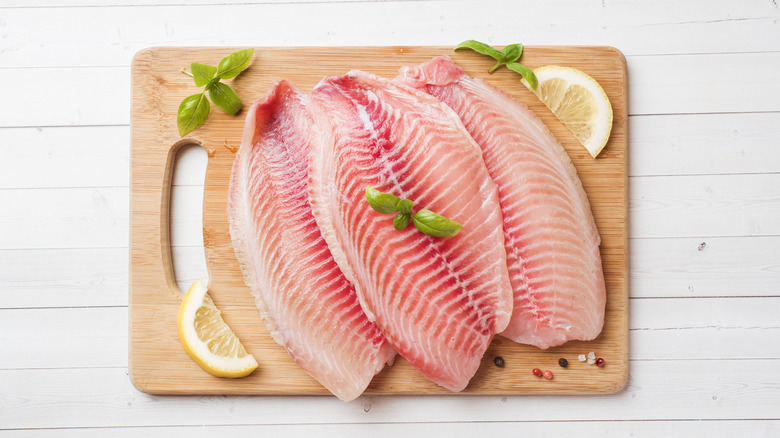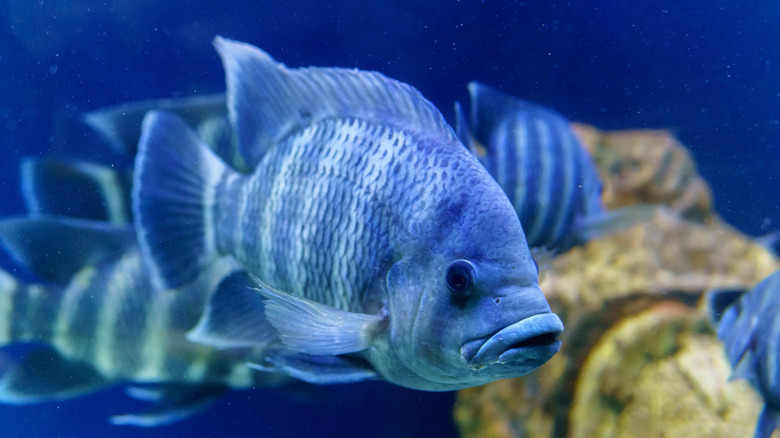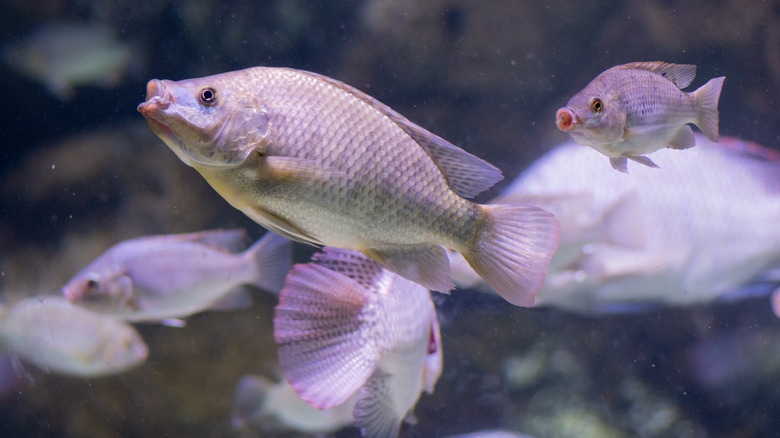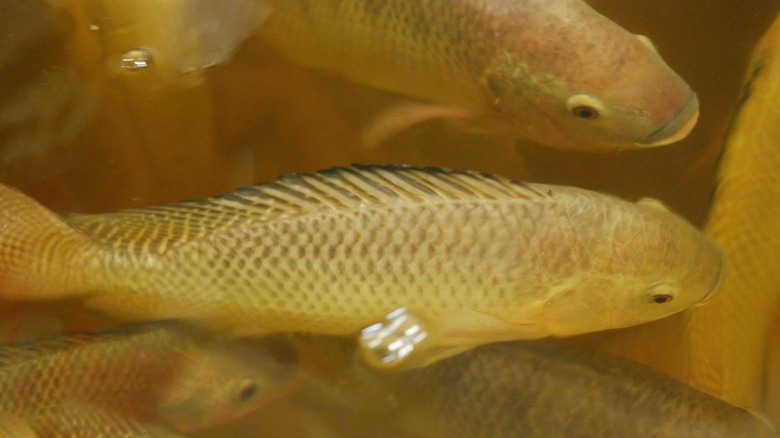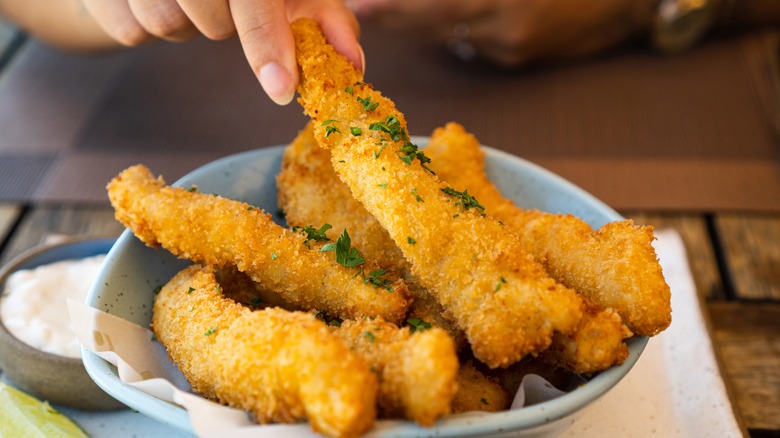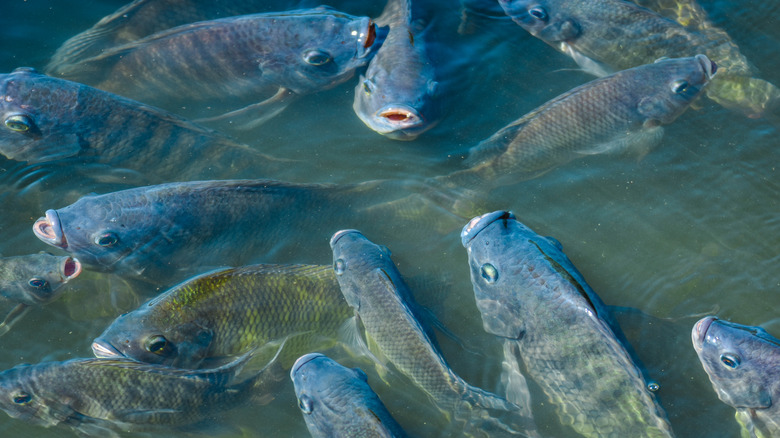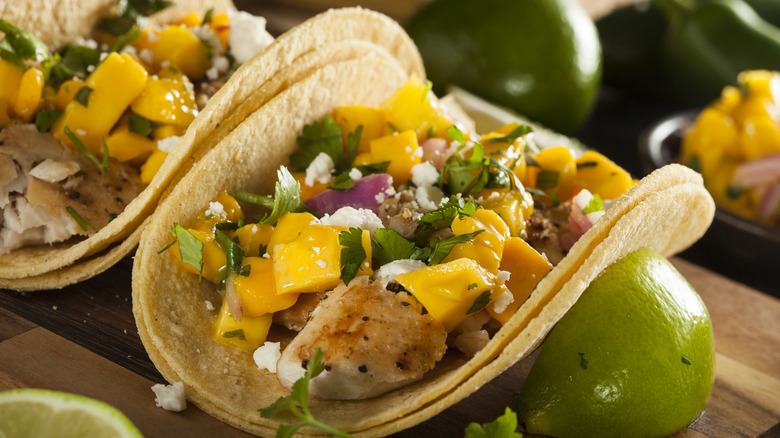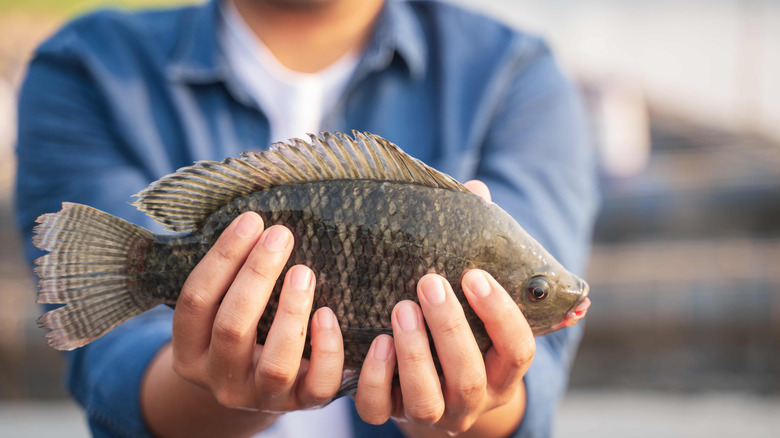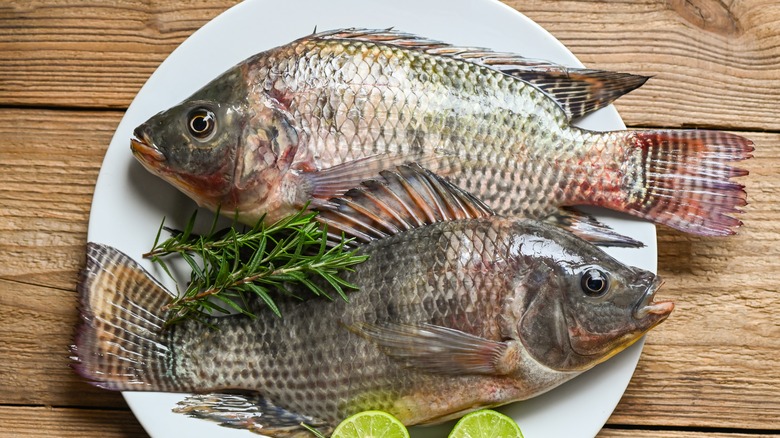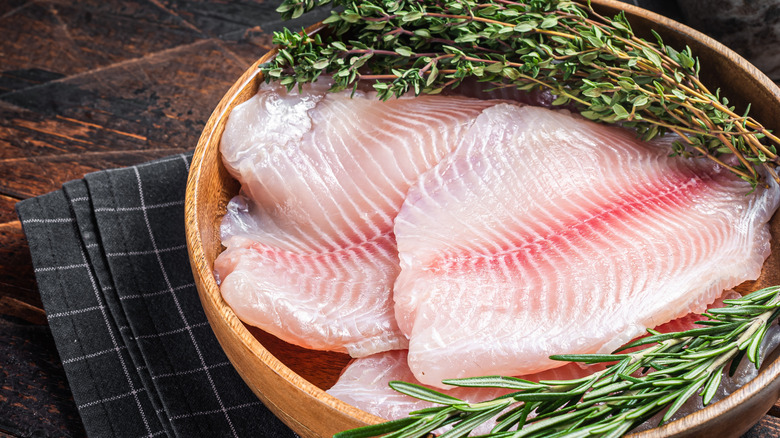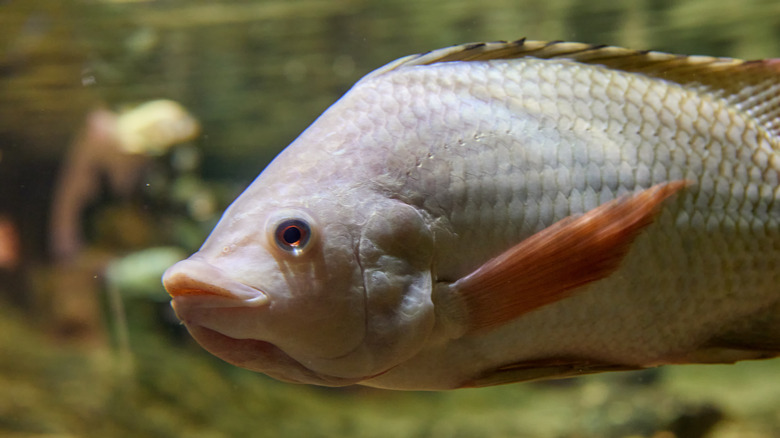Everything You Need To Know Before Buying Tilapia
When you're trying to eat a little healthier, it's something you hear over and over again: Fish is good for you. And it is! Healthline calls fish one of the most nutritious foods you can eat, for a whole bunch of science-backed reasons. It's full of nutrients, vitamins, and good fats, and it's been found to do everything from lower your risk of heart attacks to boost brain health and even fight depression.
Not all fish is created equal, though, and one of the types you've probably heard a lot about is tilapia. It's definitely not up there with salmon as far as highly sought-after types of fish go, and you've probably heard as many bad things about tilapia as you've heard good things about fish. But how much of it is true?
It turns out that there's a lot of misinformation out there about tilapia. At the same time there are a lot of rumors definitely not based in science fact, there's still both good and bad news for anyone who's looking at this as a more affordable — but still good-for-you — fish option. Let's take a look at the real story behind tilapia.
Let's talk about those tilapia rumors you've heard
The internet is a weird place, and if you happened to glance at social media at any time since 2017, you might have seen a meme going around about tilapia. It claimed that tilapia is a "mutant," that putting it on your plate is worse than eating a hamburger, that it's full of cancer-causing toxins, and that it can't be overcooked, has no skin, and no bones.
And that's super weird, because the same meme has a picture of a tilapia, and clearly, it has skin. So that's one debunked right there. (And yes, it also has bones.) There is some truth to the meme, but it's not what you might think. Claims that most tilapia come from farms and are raised on GMO foods (like corn and soybeans) is true or likely to be true, depending on where you're sourcing your fish from. But the whole idea that's dangerous is completely bogus.
And the hamburger thing? That actually comes from a misreading of a 2008 study that found tilapia is lower in omega-3 fatty acids than other fish, which, well, that doesn't exactly make it worse than a burger, does it? Finally, those toxins. There's the potential for dangerous compounds to show up in any kind of fish — it all depends on where it's harvested — so that's another bit of scare-mongering, too.
The bad news about farmed tilapia
When it comes to tilapia, a lot of what you'll find at your grocery store has been farm-raised. It's a popular fish for raising under controlled environments, mostly because it's extremely hardy and can thrive under a variety of conditions.
But, there's some things you should know about farmed tilapia, and according to The Washington Post, that same hardiness can be dangerous. Since tilapia are so tough, fish that escape from farms can very quickly spread throughout an area and that can devastate local populations of fish already living there.
And, as with any type of farm-raised foods, there are good practices and bad practices. The bad include fish that are raised in extremely cramped and crowded conditions that allow disease to spread quickly, and farms that aren't all that concerned about what they're dumping into surrounding waters, whether that's escaped fish populations or disease-controlling chemicals. According to the Monterey Bay Aquarium's Seafood Watch, if you want to stay away from tilapia farmed under questionable circumstances you should stay away from anything that's been farmed in then imported from China.
The good news about farmed tilapia
It's not all bad news when it comes to farmed tilapia, and the Monterey Bay Aquarium's Seafood Watch says that if you're looking for tilapia that have been raised under responsible, environmentally friendly conditions, those from Peru and Ecuador are particularly good options. The Ocean Wise Seafood Program adds that tilapia from Mexico, Indonesia, and Honduras are also eco-friendly options, along with anything that's farmed in a recirculating aquaculture system in the U.S.
And, according to The Washington Post, when tilapia are raised right, they're a super environmentally friendly fish. Sure, they don't pack the nutritional wallop other types of fish might, but it's still a good, low-calorie source of protein. And even though you might hear a lot about how wild-caught fish tastes much better than farm-raised, that doesn't seem to be the truth with tilapia. When The Post did a blind taste test with both fishery experts and chefs (including Wolfgang Puck chef Scott Drewno), they found that farmed tilapia wasn't nearly the horrible-tasting fish they had expected. Among samples that included red snapper and rainbow trout, most panelists couldn't even tell which was actually the tilapia.
Is tilapia as healthy as other types of fish?
Tilapia has a bad reputation when it comes to just how healthy it is, so what's the real story?
First, the good news. Healthline says that even though it's a super low-calorie fish, it's also got a ton of protein — 26 grams in a 3.5 ounce serving. It's also high in B12, niacin, and potassium, all while being low in fat, too. But that fat is where the problem lies.
You've undoubtedly heard of omega-3 fatty acids, and you know it's a good thing. But when you compare tilapia to salmon, you'll find that serving of salmon has about 10 times the omega-3. What tilapia does have a lot of is omega-6 fatty acids, and that's not nearly as good for you as the other stuff. In fact, some health experts caution about eating it at all if you're trying to stay away from foods that cause inflammation, and particularly if you're at high risk of developing heart disease.
That said, should you eat it? They recommend moderation, and when you do, they stress that you should only eat tilapia from reputable sources, and skip the stuff that's imported from China.
But you've heard tilapia is worse than bacon, right?
Tilapia seems to have gotten more than a fair share of hate, and part of that hate includes a rumor floating around on the internet and claiming that when you eat it, you're actually eating something worse for you than bacon. Pseudo-nutritionists were posting the bacon-tilapia claims even into 2018, and fear-mongering can be incredibly convincing, even when it's exaggerating the truth.
So, what is the truth? The bacon rumor got started thanks to a 2008 study published in the Journal of the American Dietetic Association. They were looking at the ratio of omega-3s to omega-6s in tilapia, and found that it was roughly 2 to 1. Sure, that's not great, but let's put this into perspective. Omega-6 is found in much higher amounts in other foods — like seeds and nuts — and the average American diet includes a omega-3 to omega-6 ratio of around 16 to 1. Bacon is also loaded with calories, saturated fat, and sodium. That's a lot worse than what's in tilapia, so bottom line? Saying it's worse than eating bacon is just downright silly and absolutely untrue.
What are genetically-improved farmed tilapia?
In 1988, WorldFish kicked off the Genetically Improved Farmed Tilapia project with the goal of perfecting a strain of tilapia for raising on a commercial scale. Why tilapia? It was already pretty perfect for the project, already hardy, disease-resistant, and having the ability to survive in a wide range of both freshwater and marine environments.
What followed was a "systematic breeding program" where researchers selected the fish with the genetic traits they wanted to pass on and bred those fish. Since fish have so many offspring, the process went fairly rapidly and GIFT were created.
GIFT are tilapia that grow 85% faster than the tilapia they started the program with, which were, (via FAO), wild tilapia from Senegal, Kenya, Ghana, and Egypt, as well as farmed tilapia from Thailand, Israel, Singapore, and Taiwan. The new strain of tilapia was distributed across the globe, and by 2003, 68% of tilapia produced in the Philippines and 46% in Thailand were of the GIFT strain. By 2010, 75% of brood stock in fisheries in Bangladesh were GIFT, and among those who have benefited the most from the engineered stock have been small-scale farmers in developing countries who are able to feed more people with these faster-growing fish.
Are tilapia really raised on poop?
Let's talk about another thing you've probably heard about tilapia, and get to the bottom of it. Rumor has it, notes The Washington Post, that tilapia isn't good for you because a lot of it is fed with livestock waste. That's not entirely a rumor, either — it comes from the USDA's 2009 report on how fish imported from China were raised.
But they also say that the idea of turning farmyard waste into a viable product that can be used to feed the masses is something we should be hoping for, not condemning. It would be like figuring out how to turn all our plastic waste into crop fertilizer: in other words, an environmental miracle. But does it still happen?
Sort of. According to Seafood Watch, (via The Washington Post) manure is used in the process of raising fish a lot, but it's usually dumped into ponds to feed plankton and other little creatures and organisms that the fish actually eat. But there's another problem, says Healthline. Using agricultural waste products like this actually increases the chance bacteria like salmonella will find its way into the fish and — ultimately — it increases the chance it's going to make it to your plate. Again, the report was looking specifically at farm-raised tilapia in China (which supplies more than 70% of the tilapia in the U.S.), so there's another reason you'll want to find out just where your fish came from.
Should you be concerned about drug and chemical residue in tilapia?
Sure, fish is good for you, but we all know fish comes from the water and unfortunately, thanks to years and years of abuse, the planet's waters are pretty gross. Contaminants are a concern when it comes to any kind of fish, so where does tilapia fall?
It all depends on where they come from and how they were raised. It's entirely possible that your farm-raised tilapia is going to contain low levels of antibiotics, and while that's not enough to hurt you alone, it could possibly add to the growing problem of developing antibiotic resistance.
But there's also good news. When the Journal of Food Processing & Technology looked at samples for anti-microbials and heavy metals, they found that while there was the occasional bit of residue, anything that did show up was well below the levels the FDA says we need to be concerned about. In fact, the FDA says that thanks to consistently low mercury levels, tilapia is one of the best choices for women who are pregnant or breastfeeding, and recommends two to three servings a week (of tilapia or a number of other fish, like cod, haddock, and salmon).
But, there's a footnote to this. Healthline notes that harmful levels of chemicals — including additives and veterinary drug residue — are regularly found in tilapia imported from China, so there's another reason to ask just where your fish came from before you buy.
Tilapia's skin has a pretty cool use
It turns out that tilapia isn't just for eating, and in Brazil, doctors have found an absolutely brilliant use for part of the fish that's usually thrown away: the skin.
According to Scientific American, finding tissues to help protect the damaged skin of burn victims is tough in Brazil, a country that doesn't have widespread access to some of the tissues (like pig skin and artificial alternatives) used in other parts of the world. With skin banks only able to keep up with about 1% of the demand, researchers started looking elsewhere.
What they found was tilapia skin. A number of the collagens needed to treat burns exist naturally in tilapia skin, and that means the skin can be applied to patients once (or a few times, for severe burns) until they heal. It's been found to not only promote healing, but also to relieve pain to the point where the need for pain medication is greatly reduced. More testing has found that it's more resistant, sturdier, and cheaper than many other options, providing a whole new use for this easily-bred fish.
You've probably eaten tilapia, even if you think you haven't
Think you've never eaten tilapia? We hate to break it to you, but you probably have — when you thought you were paying for a much more expensive type of fish.
Seafood fraud is rampant, and, (via CNN), as much as 21% of seafood is mislabeled. And that's as of March 2019 — advocacy groups and investigators have been trying to stop the mislabeling of seafood for years. The worst offenders were restaurants and small markets, and among the most commonly mislabeled fish were sea bass and snapper. A shocking 55% of the time, customers weren't getting sea bass, and they weren't getting snapper 42% of the time. Instead, they were getting tilapia or giant perch.
Oceana also says they found tilapia substituted for fish that was labeled Alaskan or Pacific cod, and just how badly fish is misrepresented — and how often tilapia is substituted — varies. They do say that if you want to know what you're really getting, large chain grocery stores do have the best record when it comes to accurately labeling exactly what it is they're selling.
Should you add tilapia to your menu?
So, here's the million dollar question: with all the naysayers, should you add tilapia to your menu, or skip it?
Well, that depends. If someone in your family doesn't like fish, tilapia might just be the perfect gateway fish. It's super mild, very lean, and it doesn't have that strong "fishy" taste and smell that turns a lot of people off from fish. Since it'll take on the flavor of whatever you season it with, you can definitely start here for the fish-hater of the family. The National Fisheries Institute says that at the end of the day, tilapia is perfectly safe. It's low-calorie, super sustainable, and ultra versatile.
But if you're looking for fish for that nutritional punch you've heard so much about, Medical News Today adds there are other fish that contain more omega-3 fatty acids and therefore might be a better option. Those are fish like red snapper, trout, cod, salmon, mackerel, and even sardines, but here's the thing — since those are fish that are often mislabeled, you're going to want to make sure you're sourcing your fish from someone you trust.
It's all food for thought, and the more you know, the better you'll be at making informed choices for your family... especially if it means serving up some tilapia to get them eating more fish.
There are three popular types of tilapia
They might look the same by the time they reach your dinner plate, but not all tilapia are equal. In fact, according to Foods Guy, there are more than 100 different species of the fish. Of those, however, only three make up the vast majority of commercially available tilapia: Nile, Blue, and Mozambique.
Nile tilapia, as its name implies, is native to northern Africa but can now be found around the world. This includes the United States, where it's one of the most popular types of tilapia sold. If you've eaten tilapia, odds are that it was Nile. This species is distinguishable thanks to its brown-gray color, vertical tail stripes, and size (it can grow to nearly 2 feet in length and weigh almost 10 pounds).
Blue tilapia is also native to Northern Africa, as well as the Middle East. It has a bluish tint to its scales and a pinkish underbelly. It's not quite as large as its Nile counterpart, typically weighing in at about 5 to 6 pounds. Lastly is the Mozambique tilapia. This species, native to southern Africa, is olive-gray in color with a yellow underbelly. Most notably, it is the smallest of the three commercially available tilapia species, usually weighing no more than 2.5 pounds.
Ancient Egyptians revered tilapia
Tilapia may be ever-present on restaurant menus of today, but the fish has a storied history dating back thousands of years to the time of ancient Egypt. According to the archeological publication Electrum Magazine, Egyptians of the day farmed tilapia in cordoned-off ponds in the Nile River.
But tilapia was more than just something to consume back then — the fish played an important part in Egyptian culture. It was revered not just as food, but for what it represented. Female tilapia have the unique behavioral trait of carrying their newborn in their mouth to protect the infantile fish from predators. Because of this, the animals were perceived by ancient Egyptians to possess fertility powers. The Penn Museum notes the image of a tilapia fish was therefore often used to symbolize rebirth and regeneration. It wasn't uncommon for pregnant women to wear tilapia amulets, for example. The fish is also commonly seen in ancient Egyptian artwork, including in murals adorning tomb walls.
